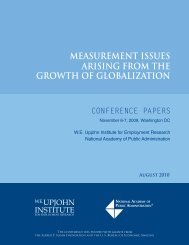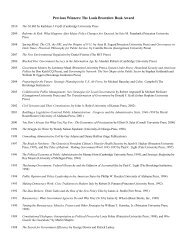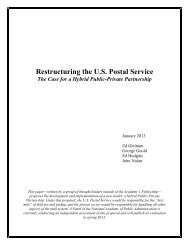High-Performance Partnerships - National Academy of Public ...
High-Performance Partnerships - National Academy of Public ...
High-Performance Partnerships - National Academy of Public ...
Create successful ePaper yourself
Turn your PDF publications into a flip-book with our unique Google optimized e-Paper software.
ORGANIZATIONAL INFRASTRUCTURE<br />
chapter nine<br />
FIGURE 9-1<br />
GOVERNANCE APPROACHES<br />
Investors vs. Stakeholder Model<br />
Decision-Makers<br />
Structure<br />
Operating Style<br />
Bias<br />
Works Best<br />
Investor<br />
Limited to those<br />
who contribute<br />
"Board <strong>of</strong> Directors"<br />
Plan & implement<br />
simultaneously<br />
Action<br />
When quick decisive<br />
action is required<br />
All Stakeholders<br />
Open to all who are<br />
interested<br />
Coalition<br />
Plan until all interests<br />
are addressed<br />
Consensus building<br />
When seeking to develop<br />
a broad-base <strong>of</strong> support to<br />
establish a need to act<br />
A broad governance structure that engages<br />
customers and community representatives may<br />
improve buy-in at the expense <strong>of</strong> operations<br />
efficiency. This approach generally is more<br />
time-consuming, but advantageous in dynamic<br />
situations and environments where consensus is<br />
required for success. The downside is that decision-making<br />
can be cumbersome and slow. Key<br />
partners, especially those used to the bottom<br />
line, can become frustrated with the process and<br />
decline to participate. Partnership governance<br />
also may be co-opted by parochial agendas.<br />
The Strategy<br />
The goal <strong>of</strong> a high-performance partnership<br />
should be to convert stakeholders into investors.<br />
This way, all parties contribute something to the<br />
partnership’s success. No stakeholder is merely a<br />
beneficiary. Rather, it has contributed something<br />
<strong>of</strong> value. When stakeholders are investors,<br />
the governance structure may be simplified<br />
because parties have a more comprehensive<br />
understanding <strong>of</strong> the components and<br />
resources. A single decision-making group or<br />
steering committee may be sufficient to address<br />
a partnership’s inherent interests.<br />
A differential governance structure probably<br />
will be more effective for a partnership that<br />
has some stakeholders that are not yet<br />
investors. The structure could follow several<br />
models. First, non-investor stakeholders could<br />
be assigned different powers. Or, they could be<br />
allocated fewer members or votes.<br />
A second approach involves a two-tiered governance<br />
structure. Tier one is composed <strong>of</strong> an<br />
array <strong>of</strong> stakeholders, including investors, customers,<br />
and community representatives. This<br />
group provides general guidance and feedback<br />
on the partnership’s goals and activities. It also<br />
can serve as a conduit for important stakeholder-partnership<br />
communications. Tier two<br />
has a smaller group <strong>of</strong> decision-makers: key<br />
investors. This body governs the partnership,<br />
allocates resources, and is accountable for performance.<br />
The larger stakeholder group must<br />
trust the smaller decision-making body for the<br />
tier two structure to be effective.<br />
No one approach is perfect for every situation.<br />
Each governance model has attributes that are<br />
conducive to different circumstances. The<br />
governance roles for the investors and beneficiaries<br />
may depend on the maturity <strong>of</strong> the part-<br />
114 Powering the Future: <strong>High</strong>-<strong>Performance</strong> <strong>Partnerships</strong>









